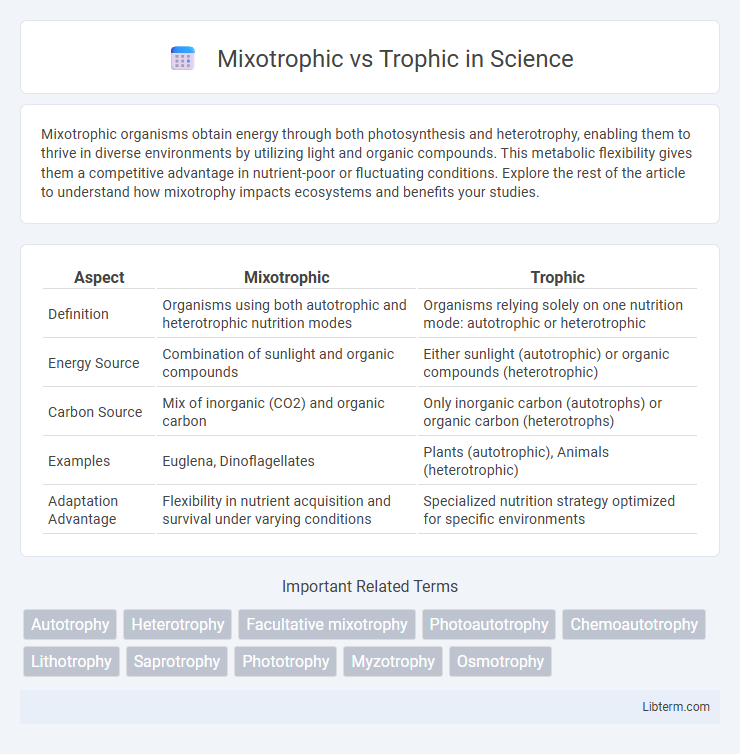Mixotrophic organisms obtain energy through both photosynthesis and heterotrophy, enabling them to thrive in diverse environments by utilizing light and organic compounds. This metabolic flexibility gives them a competitive advantage in nutrient-poor or fluctuating conditions. Explore the rest of the article to understand how mixotrophy impacts ecosystems and benefits your studies.
Table of Comparison
| Aspect | Mixotrophic | Trophic |
|---|---|---|
| Definition | Organisms using both autotrophic and heterotrophic nutrition modes | Organisms relying solely on one nutrition mode: autotrophic or heterotrophic |
| Energy Source | Combination of sunlight and organic compounds | Either sunlight (autotrophic) or organic compounds (heterotrophic) |
| Carbon Source | Mix of inorganic (CO2) and organic carbon | Only inorganic carbon (autotrophs) or organic carbon (heterotrophs) |
| Examples | Euglena, Dinoflagellates | Plants (autotrophic), Animals (heterotrophic) |
| Adaptation Advantage | Flexibility in nutrient acquisition and survival under varying conditions | Specialized nutrition strategy optimized for specific environments |
Introduction to Trophic Strategies
Mixotrophic organisms combine autotrophic and heterotrophic trophic strategies, enabling them to both photosynthesize and consume organic matter for energy, enhancing survival in variable environments. Trophic strategies broadly categorize organisms based on their energy and carbon acquisition methods, including autotrophy (self-feeding via photosynthesis or chemosynthesis) and heterotrophy (feeding on others). Understanding these strategies clarifies ecological roles and nutrient cycling within ecosystems, highlighting the adaptive advantages of mixotrophy over strictly autotrophic or heterotrophic modes.
What is Mixotrophy?
Mixotrophy refers to an organism's ability to combine autotrophic and heterotrophic modes of nutrition, allowing it to obtain energy and carbon from both photosynthesis and organic compounds. This nutritional flexibility provides a survival advantage in fluctuating environmental conditions where light or nutrients may be limited. Mixotrophic organisms include certain algae, protists, and bacteria that balance energy acquisition strategies to optimize growth and reproduction.
Defining Traditional Trophic Modes
Traditional trophic modes classify organisms based on their primary energy and carbon sources, dividing them into autotrophs that produce organic compounds through photosynthesis or chemosynthesis, and heterotrophs that consume organic matter for energy. Mixotrophic organisms combine autotrophic and heterotrophic modes, utilizing both inorganic and organic sources depending on environmental conditions. This dual strategy enhances ecological flexibility and nutrient acquisition compared to traditional, singular trophic classifications.
Key Differences: Mixotrophic vs Trophic
Mixotrophic organisms combine autotrophic and heterotrophic nutrition by utilizing both photosynthesis and organic carbon sources, whereas trophic modes include distinct categories such as autotrophic, heterotrophic, and mixotrophic based on energy and carbon acquisition. Mixotrophs exhibit metabolic flexibility, enhancing survival in fluctuating environmental conditions unlike purely autotrophic or heterotrophic entities that rely on a single nutrition mode. Key differences lie in energy utilization pathways, carbon sources, and ecological roles, with mixotrophs contributing to nutrient cycling and ecosystem stability through versatile trophic strategies.
Evolutionary Advantages of Mixotrophy
Mixotrophy offers evolutionary advantages by enabling organisms to utilize both autotrophic and heterotrophic nutrition, enhancing survival in fluctuating environmental conditions. This dual metabolic strategy increases resource flexibility, allowing mixotrophs to exploit available light and organic matter efficiently. Consequently, mixotrophic species often exhibit higher growth rates and resilience compared to strictly autotrophic or heterotrophic organisms.
Ecological Roles in Ecosystems
Mixotrophic organisms combine photosynthesis and heterotrophic nutrition, enhancing nutrient cycling and energy flow in ecosystems by utilizing both inorganic and organic sources. Trophic organisms strictly follow distinct feeding levels, either as producers, consumers, or decomposers, maintaining the structure and stability of food webs. Mixotrophy increases ecosystem resilience by allowing flexibility in resource acquisition under varying environmental conditions.
Energy Acquisition Methods Compared
Mixotrophic organisms acquire energy through both photosynthesis and heterotrophic consumption, enabling them to adapt to varying environmental conditions by utilizing light and organic compounds. In contrast, trophic classifications strictly separate energy acquisition into autotrophic mechanisms, like photosynthesis, or heterotrophic methods, such as ingestion or absorption of organic matter. This dual capacity in mixotrophs enhances energy efficiency and ecological flexibility compared to singular trophic strategies.
Adaptation and Survival Strategies
Mixotrophic organisms combine autotrophic and heterotrophic nutrition, allowing adaptation to fluctuating environmental conditions by utilizing both light energy and organic compounds for survival. This dual metabolic strategy enhances resilience in nutrient-poor or variable habitats, promoting energy efficiency and resource flexibility. In contrast, strictly trophic organisms rely solely on one nutritional mode, limiting their adaptability but optimizing specialization in stable environments.
Examples of Mixotrophic and Trophic Organisms
Mixotrophic organisms, such as Euglena, Dinoflagellates, and certain green algae, can obtain energy through both photosynthesis and heterotrophic means, allowing them to adapt to varying environmental conditions. In contrast, strictly trophic organisms include autotrophs like plants and algae that solely rely on photosynthesis, and heterotrophs such as animals, fungi, and most bacteria that depend entirely on organic substances for nutrition. These examples highlight the nutritional versatility of mixotrophs compared to the specialized feeding strategies of autotrophic and heterotrophic trophic groups.
Future Perspectives in Trophic Research
Future perspectives in trophic research emphasize the integration of mixotrophic organisms' roles in ecosystem dynamics, recognizing their dual capacity for photosynthesis and heterotrophy as key to nutrient cycling and energy flow. Advances in molecular techniques and metabolic modeling are expected to unravel complex interactions between mixotrophs and traditional trophic levels, enhancing predictions of ecosystem responses to environmental changes. This focus on mixotrophy reshapes understanding of food web structures and offers new strategies for managing biodiversity and ecosystem stability under global stressors.
Mixotrophic Infographic

 libterm.com
libterm.com